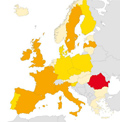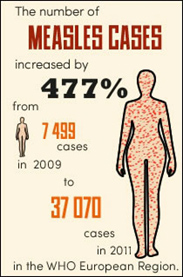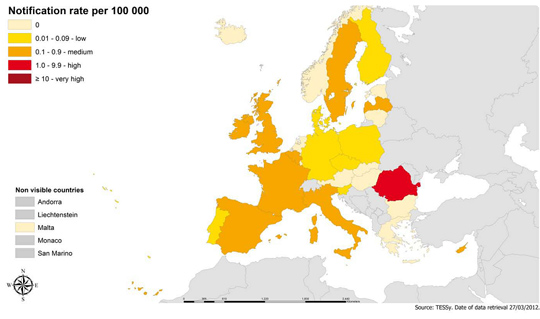 Now though, we could be seeing the earliest signs of a reprieve. At 1,447, the number of cases is still well above the levels seen five years ago but there were substantially fewer reported measles infections in January and February this year than there were in the first two months of 2011.
Now though, we could be seeing the earliest signs of a reprieve. At 1,447, the number of cases is still well above the levels seen five years ago but there were substantially fewer reported measles infections in January and February this year than there were in the first two months of 2011.
A new report from the European Centre of Disease Prevention and Control (ECDC) reveals two cases of measles-related encephalitis – an infection causing swelling of the brain – and no deaths in January and February.
Vaccine-preventable illness
Measles is a vaccine-preventable disease so these two cases of encephalitis are two too many but it is still heartening to see a downward trend for a change. In fact last year the trend increased dramatically after January before falling off at the end of May. This time, there were fewer cases in February than January so the graph is moving in the right direction.
Of course, two points on a chart are not worth getting too excited about but if the disease is spreading more slowing this year, we have reason to hope that 2012 might be better than 2011 and 2010.
At the end of January, the ECDC warned that measles rates were expected to rise as spring turned into summer. There is nothing in the new report to contradict this – the peak may well occur in April or May – but the overall trend should be an improvement on last year.

And now, the bad news
Europe could be making progress against measles but these overall figures can mask pockets of disease. For example, there has been an outbreak in the north west of England where the situation is described as the worst local epidemic in almost 25 years. Spain has also seen local outbreaks.
Authorities are warning football fans of a major measles outbreak in Ukraine ahead of the UEFA European Championships taking place there this summer.
And then there’s Romania. More than half (56%) of the cases in the 29 European countries reporting to the ECDC were recorded in Romania. That’s 816 people in two months, infected with a preventable disease.

Europe is committed to eliminating measles by 2015. According to health authorities and professional medical bodies, this requires sustained vaccination coverage above 95% with two doses of a measles-containing vaccine – such as the MMR vaccine.
For the 2015 target to be achieved, the hint of a positive trend which was seen in January and February will need to continue.
Read: Warning: Europe braces for fresh measles surge




